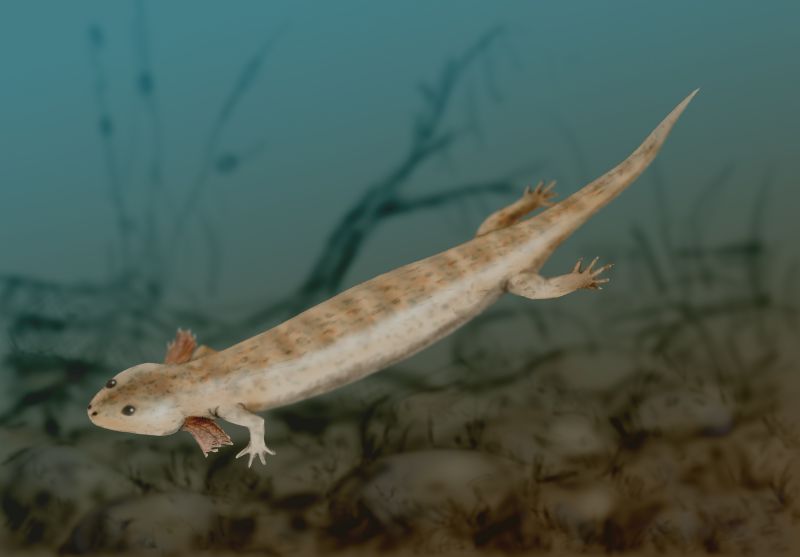Microbrachis on:
[Wikipedia]
[Google]
[Amazon]
''Microbrachis'' is an extinct genus of
 ''Microbrachis'' was an elongated,
''Microbrachis'' was an elongated,
Microbrachis, The Type Microsaur (abstract)
* Microsauria Carboniferous amphibians of Europe Kasimovian genus first appearances Gzhelian genus extinctions Prehistoric amphibian genera Fossils of the Czech Republic Fossil taxa described in 1875 {{Lepospondyli-stub
lepospondyl
Lepospondyli is a diverse taxon of early tetrapods. With the exception of one late-surviving lepospondyl from the Late Permian of Morocco (''Diplocaulus minumus''), lepospondyls lived from the Early Carboniferous ( Mississippian) to the Early Per ...
amphibian
Amphibians are tetrapod, four-limbed and ectothermic vertebrates of the Class (biology), class Amphibia. All living amphibians belong to the group Lissamphibia. They inhabit a wide variety of habitats, with most species living within terres ...
from the Carboniferous
The Carboniferous ( ) is a geologic period and system of the Paleozoic that spans 60 million years from the end of the Devonian Period million years ago ( Mya), to the beginning of the Permian Period, million years ago. The name ''Carbonifero ...
Kladno Formation
Kladno (; german: Kladen) is a city in the Central Bohemian Region of the Czech Republic. It has about 67,000 inhabitants. It is the largest city in the region and together with its adjacent suburban areas has a population of more than 110,000.
...
of the Czech Republic
The Czech Republic, or simply Czechia, is a landlocked country in Central Europe. Historically known as Bohemia, it is bordered by Austria to the south, Germany to the west, Poland to the northeast, and Slovakia to the southeast. The ...
.
Description
 ''Microbrachis'' was an elongated,
''Microbrachis'' was an elongated, salamander
Salamanders are a group of amphibians typically characterized by their lizard-like appearance, with slender bodies, blunt snouts, short limbs projecting at right angles to the body, and the presence of a tail in both larvae and adults. All ten ...
-like creature, about long, with over 40 vertebra
The spinal column, a defining synapomorphy shared by nearly all vertebrates,Hagfish are believed to have secondarily lost their spinal column is a moderately flexible series of vertebrae (singular vertebra), each constituting a characteristic ...
e instead of the average 15–26 in its living relatives. It had minute limbs, and probably swam using fish
Fish are aquatic, craniate, gill-bearing animals that lack limbs with digits. Included in this definition are the living hagfish, lampreys, and cartilaginous and bony fish as well as various extinct related groups. Approximately 95% of li ...
-like lateral body movements. ''Microbrachis'' probably fed on fresh water plankton
Plankton are the diverse collection of organisms found in Hydrosphere, water (or atmosphere, air) that are unable to propel themselves against a Ocean current, current (or wind). The individual organisms constituting plankton are called plankt ...
such as shrimp
Shrimp are crustaceans (a form of shellfish) with elongated bodies and a primarily swimming mode of locomotion – most commonly Caridea and Dendrobranchiata of the decapod order, although some crustaceans outside of this order are refer ...
. ''Microbrachis'' was pedomorphic
Neoteny (), also called juvenilization,Montagu, A. (1989). Growing Young. Bergin & Garvey: CT. is the delaying or slowing of the Physiology, physiological, or Somatic (biology), somatic, development of an organism, typically an animal. Neoteny is ...
, retaining its larva
A larva (; plural larvae ) is a distinct juvenile form many animals undergo before metamorphosis into adults. Animals with indirect development such as insects, amphibians, or cnidarians typically have a larval phase of their life cycle.
The ...
l gill
A gill () is a respiratory organ that many aquatic organisms use to extract dissolved oxygen from water and to excrete carbon dioxide. The gills of some species, such as hermit crabs, have adapted to allow respiration on land provided they are ...
s in adulthood. Similar traits are found in the extant axolotl
The axolotl (; from nci, āxōlōtl ), ''Ambystoma mexicanum'', is a paedomorphic salamander closely related to the tiger salamander. Axolotls are unusual among amphibians in that they reach adulthood without undergoing metamorphosis. Instea ...
.
References
Further reading
* Andrew R. Milner, "The Tetrapod Assemblage from Nýrany, Czechoslovakia", in Systematics Association Special Volume No.15, "The Terrestrial Environment and the Origin of Land Vertebrates", ed. by A. L. Panchen, 1980, pp. 439–496, Academic Press, London and New YorkExternal links
Microbrachis, The Type Microsaur (abstract)
* Microsauria Carboniferous amphibians of Europe Kasimovian genus first appearances Gzhelian genus extinctions Prehistoric amphibian genera Fossils of the Czech Republic Fossil taxa described in 1875 {{Lepospondyli-stub